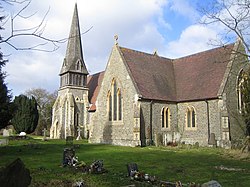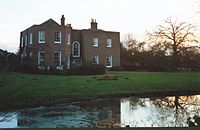Barkham: Difference between revisions
Created page with "{{Infobox town |name=Barkham |county=Berkshire |picture=Barkham, St James Church - geograph.org.uk - 135120.jpg |picture caption=St James' parish church |os grid ref=SU7867 |l..." |
No edit summary |
||
| (2 intermediate revisions by one other user not shown) | |||
| Line 16: | Line 16: | ||
|website=[http://www.barkham.org.uk/ Barkham] | |website=[http://www.barkham.org.uk/ Barkham] | ||
}} | }} | ||
'''Barkham''' is a village in [[Berkshire]] to be found | '''Barkham''' is a village in [[Berkshire]] to be found two miles south-west of [[Wokingham]]. | ||
The old part of Barkham is the small settlement by the parish church at {{map|SU781666}} and close to Barkham Street. However most of the population lives in the northeast of the parish, around the post office, or in the Arborfield Garrison, which is largely in Barkham, as is the REME Museum of Technology. It is a rural parish, mostly consisting of dairy farmland and woods, despite being surrounded by the town of [[Wokingham]] and the large villages of [[Winnersh]], [[Arborfield Cross]] and [[Finchampstead]]. | The old part of Barkham is the small settlement by the parish church at {{map|SU781666}} and close to Barkham Street. However most of the population lives in the northeast of the parish, around the post office, or in the Arborfield Garrison, which is largely in Barkham, as is the REME Museum of Technology. It is a rural parish, mostly consisting of dairy farmland and woods, despite being surrounded by the town of [[Wokingham]] and the large villages of [[Winnersh]], [[Arborfield Cross]] and [[Finchampstead]]. | ||
| Line 22: | Line 22: | ||
The village gives its name to "Barkham blue"; a well known Berkshire cheese. | The village gives its name to "Barkham blue"; a well known Berkshire cheese. | ||
The name "Barkham" is derived from the Old English ''Beorc ham'' meaning "birch home" referring to the birch trees on the edge of [[Windsor]] Forest.<ref name=rbh>[http://www.berkshirehistory.com/villages/barkham.html Barkham: Royal Berkshire History]</ref> The name evolved by way of forms including ''Berkham''' in the 14th century and ''Barcombe'' in the 18th century.<ref name=Page/> | The name "Barkham" is derived from the Old English ''Beorc ham'' meaning "birch home" referring to the birch trees on the edge of [[Windsor]] Forest.<ref name=rbh>[http://www.berkshirehistory.com/villages/barkham.html Barkham: Royal Berkshire History]</ref> The name evolved by way of forms including ''Berkham''' in the 14th century and ''Barcombe'' in the 18th century.<ref name=Page>A History of the County of Berkshire - [[Victoria County History]]</ref> | ||
==Manor== | ==Manor== | ||
[[File: | [[File:Barkham Manor.jpg|left|thumb|200px|Barkham Manor]] | ||
In King Edward III's reign the income from Barkham Manor helped to pay for the rebuilding of [[Windsor Castle]] and, not long afterwards, timber from Barkham was sent to make the roof of [[Westminster Abbey]].<ref name=rbh/> | In King Edward III's reign the income from Barkham Manor helped to pay for the rebuilding of [[Windsor Castle]] and, not long afterwards, timber from Barkham was sent to make the roof of [[Westminster Abbey]].<ref name=rbh/> | ||
| Line 33: | Line 33: | ||
==Parish church== | ==Parish church== | ||
The parish church is St James. The earliest known record of the church dates from 1220. | The parish church is St James. The earliest known record of the church dates from 1220. However, the present church building was built in 1860–61<ref name=Pevsner/> or 1862.<ref name=Page/> It was designed in a 13th-century Gothic Revival style<ref name=Page/> by the architects J B Clacy and Son<ref name=Pevsner/> of Reading.<ref>{{Cite book |editor1-last=Brodie |editor1-first=Antonia |editor1-link=|editor2-last=Felstead |editor2-first=Alison |editor3-last=Franklin |editor3-first=Jonathan |editor4-last=Pinfield |editor4-first=Leslie |title=Directory of British Architects 1834–1914, A–K |year=2001 |publisher=Continuum |location=London & New York |isbn=0-8264-5513-1 |page=375}}</ref> The chancel and transepts were added<ref name=Pevsner/> or rebuilt<ref name=Page/> in 1887. The building retains two features from the earlier church: a late 13th-century wooden memorial effigy of a woman, and the late 18th-century baptismal font.<ref name=Pevsner/> | ||
The bell-tower has a ring of four bells cast in 1863 by John Warner and Sons.<ref>{{cite web |url=http://dove.cccbr.org.uk/detail.php?searchString=Barkham&DoveID=BARKHAM |title=Barkham S James |last=Davies |first=Peter |date=18 November 2006 |work=Dove's Guide for Church Bell Ringers |publisher=|accessdate=17 July 2010}}</ref> | The bell-tower has a ring of four bells cast in 1863 by John Warner and Sons.<ref>{{cite web |url=http://dove.cccbr.org.uk/detail.php?searchString=Barkham&DoveID=BARKHAM |title=Barkham S James |last=Davies |first=Peter |date=18 November 2006 |work=Dove's Guide for Church Bell Ringers |publisher=|accessdate=17 July 2010}}</ref> | ||
| Line 44: | Line 44: | ||
Another prominent farming family, the Ball family, lived in the parish from the late 15th to the mid-17th century. In America this family is frequently said to be that of George Washington's mother, Mary Ball Washington. However William Ball, once thought to have emigrated to Virginia and become Mary's great grandfather, may actually have died in London and his family lived on in eastern Berkshire for at least two more generations.<ref name=rbh/> | Another prominent farming family, the Ball family, lived in the parish from the late 15th to the mid-17th century. In America this family is frequently said to be that of George Washington's mother, Mary Ball Washington. However William Ball, once thought to have emigrated to Virginia and become Mary's great grandfather, may actually have died in London and his family lived on in eastern Berkshire for at least two more generations.<ref name=rbh/> | ||
An open field system of farming prevailed in the parish until early in the 19th century. Parliament passed the Inclosure Act for Barkham in 1813, but it was not implemented until 1821.<ref name=Page/> | An open-field system of farming prevailed in the parish until early in the 19th century. Parliament passed the Inclosure Act for Barkham in 1813, but it was not implemented until 1821.<ref name=Page/> | ||
==Village hall== | ==Village hall== | ||
Latest revision as of 18:26, 28 November 2023
| Barkham | |
| Berkshire | |
|---|---|
 St James' parish church | |
| Location | |
| Grid reference: | SU7867 |
| Location: | 51°24’7"N, -0°52’34"W |
| Data | |
| Population: | 3,511 (2001) |
| Post town: | Wokingham |
| Postcode: | RG40, RG41 |
| Dialling code: | 0118 |
| Local Government | |
| Council: | Wokingham |
| Parliamentary constituency: |
Wokingham |
| Website: | Barkham |
Barkham is a village in Berkshire to be found two miles south-west of Wokingham.
The old part of Barkham is the small settlement by the parish church at SU781666 and close to Barkham Street. However most of the population lives in the northeast of the parish, around the post office, or in the Arborfield Garrison, which is largely in Barkham, as is the REME Museum of Technology. It is a rural parish, mostly consisting of dairy farmland and woods, despite being surrounded by the town of Wokingham and the large villages of Winnersh, Arborfield Cross and Finchampstead.
The village gives its name to "Barkham blue"; a well known Berkshire cheese.
The name "Barkham" is derived from the Old English Beorc ham meaning "birch home" referring to the birch trees on the edge of Windsor Forest.[1] The name evolved by way of forms including Berkham' in the 14th century and Barcombe in the 18th century.[2]
Manor

In King Edward III's reign the income from Barkham Manor helped to pay for the rebuilding of Windsor Castle and, not long afterwards, timber from Barkham was sent to make the roof of Westminster Abbey.[1]
For many centuries the manor house was a secondary home of the Bullock family.[1] The Bull Inn public house in Barkham is named in reference to their surname.[1] The Bullocks had inherited the manor from the family of William Neville, a 13th-century valet to Thomas Cantilupe, the Bishop of Hereford and Chancellor of England, from whom the manor was originally bought.[1]
The present manor house is a late 18th-century[2] Georgian building of two wings of differing dates.[3] Barkham had two moated farm-houses.[2] One of these survives, having been divided into two cottages.[2]
Parish church
The parish church is St James. The earliest known record of the church dates from 1220. However, the present church building was built in 1860–61[3] or 1862.[2] It was designed in a 13th-century Gothic Revival style[2] by the architects J B Clacy and Son[3] of Reading.[4] The chancel and transepts were added[3] or rebuilt[2] in 1887. The building retains two features from the earlier church: a late 13th-century wooden memorial effigy of a woman, and the late 18th-century baptismal font.[3]
The bell-tower has a ring of four bells cast in 1863 by John Warner and Sons.[5]
Rev David Davies (1741–1819) was Rector of Barkham from 1782 until his death in 1819.[2] He studied the condition of the labouring poor, recorded statistics of their wages, cost of food, etc. in various districts of Great Britain[2] and published his findings in 1785 in the form of a book called Cases of Labourers in Husbandry Stated and Considered.[2]
Rev Peter Ditchfield FSA (1854–1930) was Rector of Barkham from 1886 until his death.[6] He was a Freemason, historian and prolific author. With William Page he co-edited three Berkshire volumes of the Victoria County History, which were published in 1907, 1923 and 1924.
Social and economic history
Another prominent farming family, the Ball family, lived in the parish from the late 15th to the mid-17th century. In America this family is frequently said to be that of George Washington's mother, Mary Ball Washington. However William Ball, once thought to have emigrated to Virginia and become Mary's great grandfather, may actually have died in London and his family lived on in eastern Berkshire for at least two more generations.[1]
An open-field system of farming prevailed in the parish until early in the 19th century. Parliament passed the Inclosure Act for Barkham in 1813, but it was not implemented until 1821.[2]
Village hall
Barkham Village Hall is next to St James' parish church and is owned and run by its users.[7]
Outside links
| ("Wikimedia Commons" has material about Barkham) |
- Barkham in the Domesday Book
References
- ↑ 1.0 1.1 1.2 1.3 1.4 1.5 Barkham: Royal Berkshire History
- ↑ 2.00 2.01 2.02 2.03 2.04 2.05 2.06 2.07 2.08 2.09 2.10 A History of the County of Berkshire - Victoria County History
- ↑ 3.0 3.1 3.2 3.3 3.4 Pevsner 1966, p. 75
- ↑ Brodie, Antonia; Felstead, Alison; Franklin, Jonathan et al., eds (2001). Directory of British Architects 1834–1914, A–K. London & New York: Continuum. p. 375. ISBN 0-8264-5513-1.
- ↑ Davies, Peter (18 November 2006). "Barkham S James". Dove's Guide for Church Bell Ringers. http://dove.cccbr.org.uk/detail.php?searchString=Barkham&DoveID=BARKHAM. Retrieved 17 July 2010.
- ↑ "Families: Rev. Peter Ditchfield". Arborfield Local History Society. Arborfield Local History Society. http://www.arborfieldhistory.org.uk/C20/families_Ditchfield.htm. Retrieved 8 July 2010.
- ↑ Barkham Village Hall
- A History of the County of Berkshire, Volume 3 - Victoria County History
- Pevsner, Nikolaus (1966). Berkshire. The Buildings of England. Harmondsworth: Penguin Books. p. 75.
